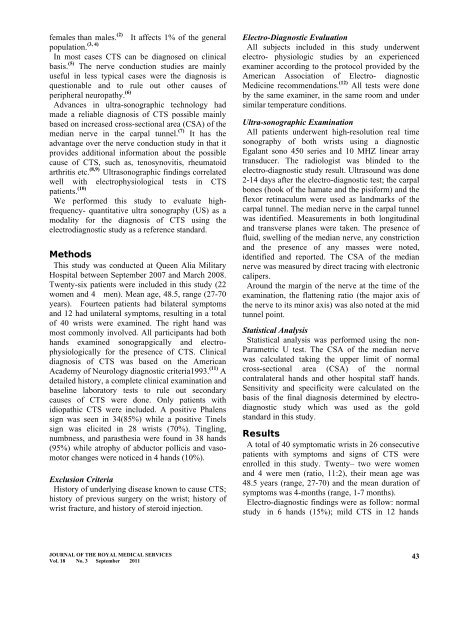High Frequency Ultrasonography in the Management of Carpal ...
High Frequency Ultrasonography in the Management of Carpal ...
High Frequency Ultrasonography in the Management of Carpal ...
Create successful ePaper yourself
Turn your PDF publications into a flip-book with our unique Google optimized e-Paper software.
females than males. (2) It affects 1% <strong>of</strong> <strong>the</strong> general<br />
(3, 4)<br />
population.<br />
In most cases CTS can be diagnosed on cl<strong>in</strong>ical<br />
basis. (5) The nerve conduction studies are ma<strong>in</strong>ly<br />
useful <strong>in</strong> less typical cases were <strong>the</strong> diagnosis is<br />
questionable and to rule out o<strong>the</strong>r causes <strong>of</strong><br />
peripheral neuropathy. (6)<br />
Advances <strong>in</strong> ultra-sonographic technology had<br />
made a reliable diagnosis <strong>of</strong> CTS possible ma<strong>in</strong>ly<br />
based on <strong>in</strong>creased cross-sectional area (CSA) <strong>of</strong> <strong>the</strong><br />
median nerve <strong>in</strong> <strong>the</strong> carpal tunnel. (7) It has <strong>the</strong><br />
advantage over <strong>the</strong> nerve conduction study <strong>in</strong> that it<br />
provides additional <strong>in</strong>formation about <strong>the</strong> possible<br />
cause <strong>of</strong> CTS, such as, tenosynovitis, rheumatoid<br />
arthritis etc. (8,9) Ultrasonographic f<strong>in</strong>d<strong>in</strong>gs correlated<br />
well with electrophysiological tests <strong>in</strong> CTS<br />
patients. (10)<br />
We performed this study to evaluate highfrequency-<br />
quantitative ultra sonography (US) as a<br />
modality for <strong>the</strong> diagnosis <strong>of</strong> CTS us<strong>in</strong>g <strong>the</strong><br />
electrodiagnostic study as a reference standard.<br />
Methods<br />
This study was conducted at Queen Alia Military<br />
Hospital between September 2007 and March 2008.<br />
Twenty-six patients were <strong>in</strong>cluded <strong>in</strong> this study (22<br />
women and 4 men). Mean age, 48.5, range (27-70<br />
years). Fourteen patients had bilateral symptoms<br />
and 12 had unilateral symptoms, result<strong>in</strong>g <strong>in</strong> a total<br />
<strong>of</strong> 40 wrists were exam<strong>in</strong>ed. The right hand was<br />
most commonly <strong>in</strong>volved. All participants had both<br />
hands exam<strong>in</strong>ed sonograpgically and electrophysiologically<br />
for <strong>the</strong> presence <strong>of</strong> CTS. Cl<strong>in</strong>ical<br />
diagnosis <strong>of</strong> CTS was based on <strong>the</strong> American<br />
Academy <strong>of</strong> Neurology diagnostic criteria1993. (11) A<br />
detailed history, a complete cl<strong>in</strong>ical exam<strong>in</strong>ation and<br />
basel<strong>in</strong>e laboratory tests to rule out secondary<br />
causes <strong>of</strong> CTS were done. Only patients with<br />
idiopathic CTS were <strong>in</strong>cluded. A positive Phalens<br />
sign was seen <strong>in</strong> 34(85%) while a positive T<strong>in</strong>els<br />
sign was elicited <strong>in</strong> 28 wrists (70%). T<strong>in</strong>gl<strong>in</strong>g,<br />
numbness, and paras<strong>the</strong>sia were found <strong>in</strong> 38 hands<br />
(95%) while atrophy <strong>of</strong> abductor pollicis and vasomotor<br />
changes were noticed <strong>in</strong> 4 hands (10%).<br />
Exclusion Criteria<br />
History <strong>of</strong> underly<strong>in</strong>g disease known to cause CTS;<br />
history <strong>of</strong> previous surgery on <strong>the</strong> wrist; history <strong>of</strong><br />
wrist fracture, and history <strong>of</strong> steroid <strong>in</strong>jection.<br />
Electro-Diagnostic Evaluation<br />
All subjects <strong>in</strong>cluded <strong>in</strong> this study underwent<br />
electro- physiologic studies by an experienced<br />
exam<strong>in</strong>er accord<strong>in</strong>g to <strong>the</strong> protocol provided by <strong>the</strong><br />
American Association <strong>of</strong> Electro- diagnostic<br />
Medic<strong>in</strong>e recommendations. (12) All tests were done<br />
by <strong>the</strong> same exam<strong>in</strong>er, <strong>in</strong> <strong>the</strong> same room and under<br />
similar temperature conditions.<br />
Ultra-sonographic Exam<strong>in</strong>ation<br />
All patients underwent high-resolution real time<br />
sonography <strong>of</strong> both wrists us<strong>in</strong>g a diagnostic<br />
Egalant sono 450 series and 10 MHZ l<strong>in</strong>ear array<br />
transducer. The radiologist was bl<strong>in</strong>ded to <strong>the</strong><br />
electro-diagnostic study result. Ultrasound was done<br />
2-14 days after <strong>the</strong> electro-diagnostic test; <strong>the</strong> carpal<br />
bones (hook <strong>of</strong> <strong>the</strong> hamate and <strong>the</strong> pisiform) and <strong>the</strong><br />
flexor ret<strong>in</strong>aculum were used as landmarks <strong>of</strong> <strong>the</strong><br />
carpal tunnel. The median nerve <strong>in</strong> <strong>the</strong> carpal tunnel<br />
was identified. Measurements <strong>in</strong> both longitud<strong>in</strong>al<br />
and transverse planes were taken. The presence <strong>of</strong><br />
fluid, swell<strong>in</strong>g <strong>of</strong> <strong>the</strong> median nerve, any constriction<br />
and <strong>the</strong> presence <strong>of</strong> any masses were noted,<br />
identified and reported. The CSA <strong>of</strong> <strong>the</strong> median<br />
nerve was measured by direct trac<strong>in</strong>g with electronic<br />
calipers.<br />
Around <strong>the</strong> marg<strong>in</strong> <strong>of</strong> <strong>the</strong> nerve at <strong>the</strong> time <strong>of</strong> <strong>the</strong><br />
exam<strong>in</strong>ation, <strong>the</strong> flatten<strong>in</strong>g ratio (<strong>the</strong> major axis <strong>of</strong><br />
<strong>the</strong> nerve to its m<strong>in</strong>or axis) was also noted at <strong>the</strong> mid<br />
tunnel po<strong>in</strong>t.<br />
Statistical Analysis<br />
Statistical analysis was performed us<strong>in</strong>g <strong>the</strong> non-<br />
Parametric U test. The CSA <strong>of</strong> <strong>the</strong> median nerve<br />
was calculated tak<strong>in</strong>g <strong>the</strong> upper limit <strong>of</strong> normal<br />
cross-sectional area (CSA) <strong>of</strong> <strong>the</strong> normal<br />
contralateral hands and o<strong>the</strong>r hospital staff hands.<br />
Sensitivity and specificity were calculated on <strong>the</strong><br />
basis <strong>of</strong> <strong>the</strong> f<strong>in</strong>al diagnosis determ<strong>in</strong>ed by electrodiagnostic<br />
study which was used as <strong>the</strong> gold<br />
standard <strong>in</strong> this study.<br />
Results<br />
A total <strong>of</strong> 40 symptomatic wrists <strong>in</strong> 26 consecutive<br />
patients with symptoms and signs <strong>of</strong> CTS were<br />
enrolled <strong>in</strong> this study. Twenty– two were women<br />
and 4 were men (ratio, 11:2), <strong>the</strong>ir mean age was<br />
48.5 years (range, 27-70) and <strong>the</strong> mean duration <strong>of</strong><br />
symptoms was 4-months (range, 1-7 months).<br />
Electro-diagnostic f<strong>in</strong>d<strong>in</strong>gs were as follow: normal<br />
study <strong>in</strong> 6 hands (15%); mild CTS <strong>in</strong> 12 hands<br />
JOURNAL OF THE ROYAL MEDICAL SERVICES<br />
Vol. 18 No. 3 September 2011<br />
43

















